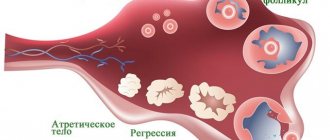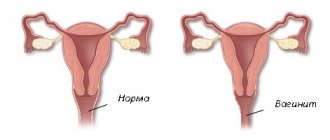How does ovulation occur?
Ovulation is the period of time when a mature egg leaves the ovary. For every representative of the fair sex after the onset of puberty, it occurs approximately two weeks after the arrival of menstruation. It turns out that you can get pregnant on the 14th day after your period. The duration of ovulation is 1 day. The regularity of both egg maturation and “critical days” is ensured by follicular and gonadotropic hormones. The release of follicular fluid can be noticed on the day of ovulation.
Ovulation can be determined by the characteristic signs of discharge. So, 14 days before the onset of the next “critical days”, some women may experience spotting during ovulation. They occur due to rupture of the follicle. This physiological process is accompanied by a sharp increase in estrogen, as a result of which the mucous membrane is slightly rejected. This phenomenon provokes the appearance of bloody smears. This sign of egg release is observed in every third woman. In other women, the mucus secreted is transparent and very similar to the white of a chicken egg.
Mucous, sticky, odorless and colorless discharge in women is the main sign of the release of a mature egg. However, even in completely healthy women, anovulatory cycles can occur at intervals of several months. In addition, egg maturation may not occur for quite a long period after an abortion, spontaneous miscarriage, or after the birth of a baby. This phenomenon is directly influenced by the production of hormones, for this reason, during the onset of menopause, the egg does not leave the follicle - the hormonal balance is disrupted, the woman can no longer have children.
Due to certain conditions, vaginal secretions may not come out at all. However, its complete absence does not mean that conception is impossible or that the girl is sick.
Signs of normal secretion
To be able to distinguish pathological discharge from normal discharge, you need to know the acceptable symptoms.
During ovulation, a rupture of the follicular cavity is observed. The walls of the dominant follicle receive oxygen from the blood. Blood fluid enters the follicle through blood vessels. Rupture of the walls leads to partial damage to small vessels. Some of the blood mixes with the follicular fluid. Against this background, on a favorable day, white discharge may acquire a pinkish color. It is rare to see a drop of blood on underwear. Such discharge should not cause alarm. They are considered a sign of a physiological process.
During this period, slight soreness in the ovarian area may be observed. This phenomenon occurs when the follicle ruptures. The large size of the dominant is accompanied by pressure on the inner wall of the peritoneum. Also, the symptom may appear against the background of an incorrect position of the uterine cavity. Deviation of the uterus towards the abdominal wall causes increased pain during ovulation.
The discharge of a healthy woman in a favorable phase should have a homogeneous structure. This quality can be determined using the finger method. A small amount of secretion is squeezed between the thumb and index finger. When you unclench your fingers, the secretion begins to stretch. The adhesive structure of the secretion appears during ovulation.
It is also necessary to monitor the color of the discharge. Normally they should be white in color. A favorable day is accompanied by discoloration of the secretion. The discharge becomes transparent. After the cessation of the action of the luteinizing substance, secretion becomes normal. All these signs are characteristic of the onset of ovulation.
Additional Tips
In order for secretion to be normal, prevention is necessary. The quality of white discharge depends on compliance with a number of rules:
- proper nutrition;
- timely visit to the gynecologist;
- maintaining intimate hygiene.
The characteristics of white discharge depend on proper nutrition. It is necessary to exclude various spicy and fatty foods from the diet. Spices have a negative effect on vaginal secretion.
It is also necessary to visit a gynecologist at least once every six months. This rule is ignored by many patients. Appeals are made only when any pathology develops. A timely visit to the doctor helps prevent the development of disease-causing processes. For this purpose, you must also carefully monitor intimate hygiene.
During ovulation, a woman experiences additional symptoms. Thanks to them, the patient can speed up the onset of conception or prevent an unwanted pregnancy. Tracking the characteristics of white discharge during ovulation helps accomplish these goals.
Vaginal discharge before ovulation
In order to learn to distinguish healthy vaginal secretions from pathological ones, you need to be aware of how many days before ovulation mucous discharge appears.
As soon as menstruation stops, there comes a period when a very thick secretion forms. Such mucous or white, creamy, odorless discharge before ovulation is the absolute norm. This causes the formation of a creamy mucous plug in the cervix, the main purpose of which is to naturally protect the reproductive organ from the penetration of sperm and pathogenic microflora.
Creamy discharge prevents secretions from leaving the uterus, which is why there is no mucus in the middle of the cycle.
Every day you can observe that the creamy leucorrhoea gradually thins out, as a result of which by the middle of the cycle you can notice traces of mucus on the daily in large quantities. Before ovulation, the discharge becomes viscous and becomes completely transparent. This is a clear sign that very soon the egg will be ready for fertilization.
Curdled white discharge with a sour odor before ovulation usually indicates the development of thrush, especially if its appearance coincides with the occurrence of severe discomfort in the intimate area. Leucorrhoea and cream form are not associated with the phase of the cycle and occur when pathogenic microflora in the vagina begins to significantly predominate.
Another symptom that can cause concern is watery discharge before ovulation. If their number and consistency are quite normal, then there is no need to worry - it is possible that the maturation of the egg has already occurred, and the woman simply made a mistake in the calculations.
The importance of cervical mucus in a woman's life
Cervical mucus is directly involved in the process of conception, so any deviation from the norm can cause a lack of fertilization. If a couple is unable to conceive, the doctor examines cervical mucus, which is collected after intercourse. If after testing the quality is assessed as poor, the woman should undergo hormone-based treatment. In addition, decreased secretion or quality of mucus can lead to sexually transmitted infections as a result of the lack of a barrier between the vagina and uterus.
How to determine ovulation by leucorrhoea
Many women ask questions about what discharge should be like during ovulation. Alternatively, you can see what the discharge looks like when ovulation occurs in a photo on the Internet and compare it with your own, but this method is unlikely to be reliable. Determining the onset of ovulation day only by the amount and consistency of mucus is an unreliable method. To find out the exact time of maturation of the female reproductive cell, folliculometry should be performed and basal temperature should be measured.
Keeping a calendar in which a woman makes monthly notes about the day of ovulation and basal temperature helps almost accurately calculate days favorable for conception.
Discharge color
Most girls' leucorrhoea on the day of ovulation is transparent, viscous, and quite abundant. The viscousness of mucus is a kind of nature’s idea, thanks to which sperm can easily reach the egg. Infrequently, ovulation discharge is yellowish or bloody. If mucus and blood are released in large volumes, it is imperative to consult a gynecologist.
In the postpartum period, pinkish daub is a sign of restoration of ovulation. Along with the changes in vaginal mucus, representatives of the fair sex often experience secondary symptoms:
- soreness in the mammary glands;
- increased sex drive;
- the appearance of pain in different parts of the body.
Cloudy white vaginal discharge at the onset of ovulation should alert you. They may indicate the predominance of pathogenic flora.
Duration of discharge
Usually, the secretion during the release of the egg is released in large volumes during the first 2-3 days. At this time, the ovaries begin to produce progesterone, and under its direct influence and level, the liquid mucus becomes denser. The onset of whitish leucorrhoea is a clear sign of the end of this period.
Important Rules
In order for the observation to give reliable results, it is necessary to follow the basic rules:
- Each cycle, on the day of the end of menstruation, determine the nature of the fluid, 3 times a day. To do this, wash your hands thoroughly and take a vaginal sample with your finger;
- Determine the quality of mucus: liquid, sticky, dry;
- To check the ductility, simply spread your fingers;
- Check the dryness of your underwear every time you go to the toilet;
- Record the results of your own research.
Vaginal secretion after ovulation
In rare cases, copious white discharge does not stop even after ovulation - the leucorrhoea continues for quite a long time, acquiring a sticky consistency. Before the next menstruation begins, the secretion becomes liquid again. Every woman needs to systematically monitor the amount and consistency of mucus secreted, because this is the only way to give a preliminary assessment of her health. So, if the mucus on the pad is very abundant, it has a very unpleasant odor, this indicates the development of candidiasis. Secondary signs of pathology are:
- curdled discharge;
- severe itching in the external genital area;
- painful sensations in the lower abdomen.
The color of the secretion is also significant: yellow, bloody, grayish, green marks on the underwear are a clear sign of an ongoing disease of an inflammatory or bacterial nature. In such a situation, it is necessary to visit a gynecologist and take a smear for examination.
Pathological changes
The nature of discharge during egg maturation usually does not change in women throughout all cycles. The appearance of any unusual signs is a reason to consult a doctor.
Bloody issues
They begin due to existing inflammatory pathologies, as well as diseases of the reproductive system. They can form in the following diseases:
- polycystic ovary syndrome;
- uterine polyps;
- hypothyroidism;
- thrombocytopathy;
- endometriosis.
Red discharge that appears on the 12th–14th day of the menstrual cycle can be a symptom of oncological pathologies developing in the reproductive organ, as well as significant trauma to the vagina. Such discharge does not just happen; it is almost always a sign of pathology.
The appearance of brown spotting should not cause concern - this is a sign of the natural release of endometrial remnants after the “critical days”. During the period of egg maturation, the cervix becomes softer, due to which the uterus is cleansed. The spotting nature of secretion, which occurs rarely, is a completely favorable phenomenon.
Systematic light brown discharge in the middle of the cycle may appear in the following cases:
- Against the background of progressive vaginal infections.
- Due to the fragility of blood vessels.
- Due to serious liver diseases.
Sometimes brown vaginal secretion acts as one of the symptoms of implantation bleeding. This condition occurs due to damage to the endometrial wall during the attachment of the fertilized egg.
Yellow discharge
Most often they appear due to developing vaginosis. In this condition, bacteria rapidly multiply in the vagina, which causes several unpleasant symptoms. They exist safely in a suitable environment, causing a characteristic clinical picture. In advanced cases, the disease even leads to infertility. Every woman should know that douching is unacceptable if you have vaginosis. The use of tampons during menstruation is prohibited. It is very important to maintain daily hygiene and change pads on time.
Yellowish secretion is a frequent companion to infectious diseases such as gonorrhea, thrush, and chlamydia. They always cause an unpleasant odor and cause severe discomfort and pain during sex.
Copious secretion
Atypical and copious discharge in the form of egg whites before or after ovulation is a reason to seek medical help. Possible gynecological disease. If bloody or excessively mucous discharge appears with the onset of menopause, you should definitely consult a doctor. Such manifestations may indicate the progression of cancer.
A cause for concern should be discharge that:
- very thick;
- having a rotten odor;
- causing itching in the vagina;
- causing an increase in temperature;
- causing severe pain in the lower abdomen.
In what situations can you not do without a visit to the doctor?
Any alarming symptoms should be a reason to contact a gynecologist. It is better not to put off a visit to the clinic for too long, because the sooner the cause of a particular phenomenon is established, the faster the pathology can be cured. A change in the color or consistency of vaginal discharge, or the appearance of a sour odor may indicate both completely normal processes in the female body and a developing disease.
If the following symptoms are present, you cannot do without the help of a doctor:
- painful sensations in phase 2 of the cycle;
- dark color of secretion;
- excessively high basal temperature;
- severe itching in the perineal area;
- rotten smell of discharge.
In the absence of any violations, vaginal secretion will never cause discomfort. But certain violations will definitely make themselves felt, and in the most unpleasant form.










